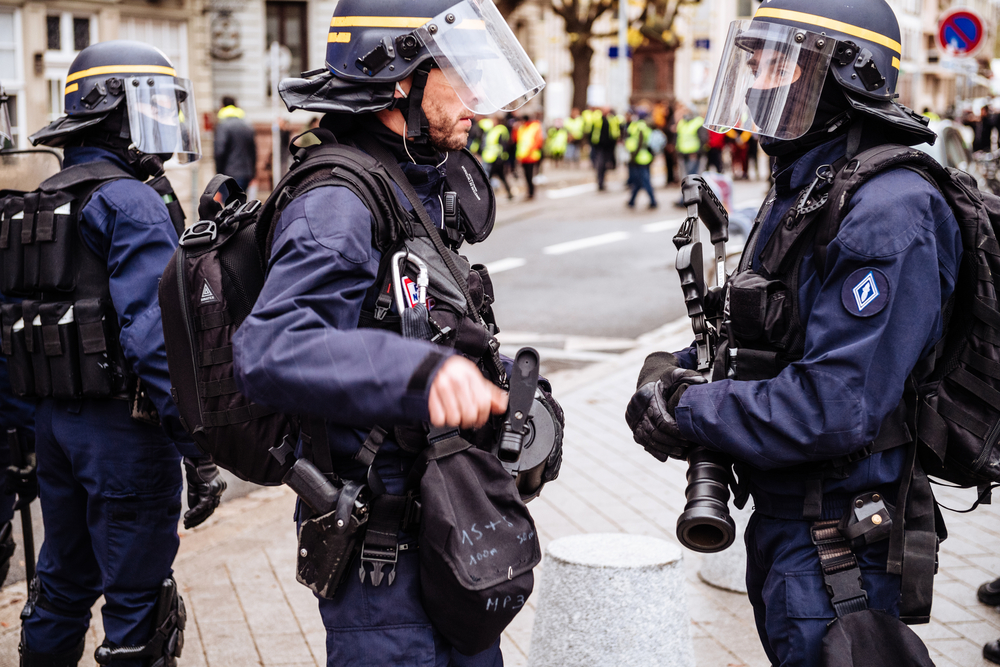Whenever police use tear gas against protestors and rioters, someone invariably asks, “Why, if tear gas is banned for use in war, is it allowed for use in law enforcement?” Ultimately, the justification appears to be, “Because there aren’t any better options.” However this practical excuse is undercut by some of the fundamental considerations of Just War Theory, which underpins international law governing warfare.
In the nationwide protests against police brutality and systemic racism sparked by the killing of George Floyd by former Minneapolis police officer Derek Chauvin, tear gas has been used by the police departments of numerous US cities, including Atlanta, Minneapolis, Philadelphia, and Washington, D.C. Tear gas is a name that refers to a variety of different chemicals, including pepper spray. All tear gas compounds act by rapidly and severely irritating people’s eyes, skin, nose, mouth, throat, and lungs. This causes people’s eyes to swell and water (hence the name “tear gas” and “lachrymator agent”) and leads to difficulty breathing. Lachrymator agents are one among many “less than lethal” weapons used in riot control, alongside rubber bullets, beanbag rounds, flash-bangs, and many others. If tear gas is non-lethal, why is it forbidden for use in warfare?
Weapons that are banned for use in warfare by international law typically have one of more features which make them mala in se (i.e., evil in themselves). Means which are mala in se are morally unacceptable for use in warfare according to Just War Theory provisions concerning jus in bello, which refers to rules governing morally appropriate conduct during the course of war. What makes a weapon malum in se? Relating to tear gas, one criterion sticks out clearly. Any weapon the effects of which cannot be controlled is malum in se. Gases are inherently not controllable because to where they drift is determined by wind speed and direction, rather than user intention. Hence police using tear gas on a group of rioters in a residential area, or a non-residential area upwind from a residential area, will likely end up affecting people nearby, and in completely different areas who are complying with the law. In the context of war using weapons that fail to discriminate, or using weapons in a manner that fails to discriminate, between combatants and non-combatants is illegal. Why then is it acceptable for police to use weapons that fail to discriminate between law-breakers and law-abiders?
Another criterion for determining whether a weapon is malum in se is its proportionality for achieving a legitimate goal. In Just War Theory, a war that has been justly entered into (jus ad bellum) allows those on the just side to use only the minimum necessary force to achieve victory by incapacitating the enemy (who is, if the war has been entered into justly, unjust by definition). Weapons and munitions that cause excessive harm to enemy combatants are prohibited in Just War Theory (and correspondingly outlawed by international accords). For example napalm and white phosphorous are both banned because they cause tremendous pain to combatants and maim them, rather than incapacitating or quickly killing them. Being exceedingly charitable to police, the use of tear gas can be seen as a proportional measure. Police, who are often outnumbered by rioters, need a method to promptly subdue rioters and restore peace without resorting to lethal means. If lethal force is the only viable alternative to weapons like tear gas, then it appears that the use of tear gas may be justified (ignoring that tear gas is malum in se because of its inherent indiscriminateness).
While tear gas is “less than lethal,” both it and the delivery system for it can cause long-term harm to people. Even people with no underlying respiratory conditions can, with extensive exposure, suffer chronic respiratory issues. Likewise extensive exposure can lead to blindness. It is an indiscriminate chemical agent that has been banned for use in warfare. Under what circumstances, if any at all, could it be acceptable to use it? If we can imagine a group of rioters recklessly or intentionally committing serious crimes, but not doing so in a place from which the tear gas is liable to spread and affect innocent citizens, then we would have found an acceptable situation. Is there any such situation? Prison riots come close to the mark. Indeed, this is one of the situations in which the US Military reserves the right to use tear gas and in which the international laws governing chemical weapons allow militaries to deploy tear gas. However the use of tear gas by police on peaceful protestors or even on rioters in close proximity to peaceful protestors or densely populated urban areas is clearly unjust. The inherently indiscriminate nature of gaseous chemical agents makes them an evil in themselves.

